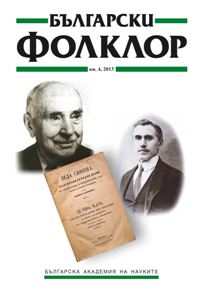Числата в художествената реалност на песенните текстове (По примери от песните, включени в том първи на “Веда Словена”)
The Numbers in the Fictive Reality of Song Lyrics (On the Examples of Songs Included in Vol. I of “Veda Slovena”)
Author(s): Gatya SimeonovaSubject(s): Customs / Folklore
Published by: Институт за етнология и фолклористика с Етнографски музей при БАН
Keywords: song; image; number; numerology; (mythic-poetic) tradition; memory
Summary/Abstract: The objective of this study is to read texts (instructional and true fictional) to bring to the attention of readers which the numbers recorded in the collection book are and how they differ in frequency of recurrence with each other, but also in terms of the well-known facts taken from ethnographic studies on the topic. Therefore we could infer that in "Veda Slovena" there are preferred numbers that coincide with the most popular numbers according to our traditional folk culture and the most commented numbers in numerology. Insofar as the song lyrics in "Veda Slovena", in this case, are considered as "artsy", the numbers are seen as a means of achieving hyperbolization of images in a world envisioned by the human imagination. An excuse for coming up with such "nonsense", according to common sense, is the search for impact effect on the listener. This effect has a more distant targets – the imaginary world has to serve as a model for the real world. Briefly with many reservations an assumption is made, provoking the scientific thought, that the song lyrics in "Veda Slovena" are a reflection of reality, not a fictional man made world. Is it really the case of a long time past in which sentient beings lived looking different than the present human beings both in size and anatomy? Whether it is a world in which thinking and feeling run at different speeds and therefore they give an impression of different duration of the described conditions and actions? This study does not exceed the level of traditional description. The novelty is that it makes a reading and puts into circulation material from a little known source, such as "Veda Slovena", with the hope to gain confidence in the two-volume work and facilitate the inclusion of data in the traditional heritage of Bulgarians. On the background there is hope that attempts will follow in undertaking semantic analysis of the numerical code in its Bulgarian use.
Journal: Български фолклор
- Issue Year: XXXIX/2013
- Issue No: 4
- Page Range: 427-442
- Page Count: 16
- Language: Bulgarian
- Content File-PDF

